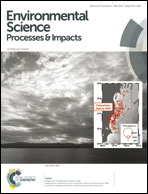A demonstration of biofiltration for VOC removal in petrochemical industries
Abstract
A biotrickling filter demo has been set up in a petrochemical factory in Sinopec Group for about 10 months with a maximum inlet gas flow rate of 3000 m3 h−1. The purpose of this project is to assess the ability of the biotrickling filter to remove hardly biodegradable VOCs such as benzene, toluene and xylene which are recalcitrant and poorly water soluble and commonly found in petrochemical factories. Light-weight hollow ceramic balls (Φ 5–8 cm) were used as the packing media treated with large amounts of circulating water (2.4 m3 m−2 h−1) added with bacterial species. The controlled empty bed retention time (EBRT) of 240 s is a key parameter for reaching a removal efficiency of 95% for benzene, toluene, xylene, and 90% for total hydrocarbons. The demo has been successfully adopted and practically applied in waste air treatments in many petrochemical industries for about two years. The net inlet concentrations of benzene, toluene and xylene were varied from 0.5 to 3 g m−3. The biofiltration process is highly efficient for the removal of hydrophobic and recalcitrant VOCs with various concentrations from the petrochemical factories. The SEM analysis of the bacterial community in the BTF during VOC removal showed that Pseudomonas putida and Klebsiella sp. phylum were dominant and shutdown periods could play a role in forming the community structural differences and leading to the changes of removal efficiencies.


 Please wait while we load your content...
Please wait while we load your content...